Contents lists available atScienceDirect
Nonlinear Analysis: Real World Applications
www.elsevier.com/locate/nonrwa
A mathematical model for Lassa fever transmission dynamics in a seasonal environment with a view to the 2017–20 epidemic in Nigeria
Mahmoud A. Ibrahim
a,b,∗, Attila Dénes
aaBolyai Institute, University of Szeged, Aradi vértanúk tere 1., Szeged, H-6720, Hungary
bDepartment of Mathematics, Faculty of Science, Mansoura University, Mansoura 35516, Egypt
a r t i c l e i n f o
Article history:
Received 23 June 2020
Received in revised form 7 February 2021
Accepted 9 February 2021 Available online xxxx Keywords:
Lassa haemorrhagic fever Periodic epidemic model Basic reproduction number Global stability
Uniform persistence
a b s t r a c t
In this paper, we formulate and study a compartmental model for Lassa fever transmission dynamics considering human-to-human, rodent-to-human transmis- sion and the vertical transmission of the virus in rodents. To incorporate the impact of periodicity of weather on the spread of Lassa, we introduce a non- autonomous model with time-dependent parameters for rodent birth rate and carrying capacity of the environment with respect to rodents. We introduce the basic reproduction number and show that it can be used as a threshold parameter concerning the global dynamics. It also shown that the disease-free periodic solution is globally asymptotically stable in the case of R0 <1 and if R0 >1, then the disease persists. We show numerical studies for the Lassa fever in Nigeria and give examples to describe what kind of parameter changes might trigger the periodic recurrence of Lassa fever.
©2021 The Author(s). Published by Elsevier Ltd. This is an open access article under the CC BY-NC-ND license (http://creativecommons.org/licenses/by-nc-nd/4.0/).
1. Introduction
Lassa haemorrhagic fever (LHF), or Lassa fever for short is a zoonotic, acute viral hemorrhagic fever caused by the Lassa virus from theArenaviridae family [1]. The disease was first described in the 1950s, though the virus causing it was only identified in 1969 [2]. The disease was named after the Nigerian town Lassa, where the first cases were observed. LHF is usually transmitted to humans via direct or indirect exposure to food or other items contaminated with urine or feces of infected multimammate rats (Mastomys natalensis), through the respiratory or gastrointestinal tracts. Person-to-person transmission has also been observed [3]. The virus remains in body fluids even after recovery: in urine for 3–9 weeks from infection and for three months in male genital secretions [3]. Lassa fever is endemic among rats in parts of West Africa, while it is endemic in humans in several countries of the region. In these regions, the number of infections
∗ Corresponding author at: Bolyai Institute, University of Szeged, Aradi v´ertan´uk tere 1., Szeged, H-6720, Hungary.
E-mail address: mibrahim@math.u-szeged.hu(M.A. Ibrahim).
https://doi.org/10.1016/j.nonrwa.2021.103310
1468-1218/© 2021 The Author(s). Published by Elsevier Ltd. This is an open access article under the CC BY-NC-ND license (http://creativecommons.org/licenses/by-nc-nd/4.0/).
Fig. 1. Lassa fever transmission. The figure shows modes of transmission (human-to-human, human-to-rodent, rodent-to-human and rodent-to-rodent).
per year is estimated between 100,000 and 300,000, with around 5000 deaths. Lassa menaces mostly those who live in rural areas where multimammate rats are present, especially where poor sanitation and crowded living conditions are typical.Fig. 1shows the possible methods of LHF transmission.
About 80% of people infected with Lassa fever have only mild or no symptoms. Symptom onset occurs usually 1–3 weeks after exposure, these include fever, tiredness, weakness, and headache. 20% of infected develop a severe multisystem disease with symptoms including bleeding gums, respiratory distress, vomiting, chest, back and abdomen pain, facial swelling, low blood pressure. Neurological problems can also be observed, such as hear loss, tremors, encephalitis. Approximately 1% of infections result in death due to multi-organ failure. However, the disease is particularly severe in women in the third trimester of their pregnancy, with high rates of maternal death (29%) observed, while an estimated 80%–95% fetal and neonatal mortality is reported [1,4,5].
Treatment of Lassa fever includes antiviral medication, fluid replacement and blood transfusions. For women in late pregnancy, inducing delivery is necessary.
Although Lassa fever appears in WHO’s Blueprint list of diseases to be prioritized for research and development [6], compared with other infectious diseases, a relatively small number of mathematical modelling studies have been published up to now. Onah et al. [7] extended anSIR–SI-type compartmental model by introducing different control intervention measures, e.g. external protection, treatment, isolation and rodent control. They used optimal control theory to determine how to reduce disease transmission with minimal cost. Musa et al. [8] established a model describing the interaction between humans and rodents including quarantine, isolation and hospitalization. The authors showed the presence of a forward bifurcation with a stability switch between the disease-free and the endemic equilibrium. Also, they fitted the model to data from 2016–19 to find that initial susceptibility increased across the three outbreaks in these years.
Zhao et al. [9] studied the epidemiological features of Lassa epidemics in various regions of Nigeria. They assessed the connection between the reproduction number and rainfall. They determined the infectivity of Lassa by the reproduction number estimated from four types of growth models. They fitted the models to Lassa surveillance data and estimated the reproduction number in various regions. Akhmetzanov et al. [10]
applied a model to study the datasets of human infection, population changes of rodents as well as weather changes to quantify the seasonal drivers of Lassa fever transmission. They obtained that seasonal migration of rats plays a key role in regulating the periodicity of Lassa epidemics. The peak exposure of humans to rats is shortly after the beginning of the dry season and correlates with the mating period of rodents.
Although some of the above works put an emphasis on the time-changing nature of Lassa transmission dynamics, so far, no compartmental model with time-dependent parameters has been established. In
this work, we set up and study a compartmental epidemic model for Lassa fever transmission dynamics considering infected humans with mild or severe symptoms, treatment, human-to-human and rodent-to human transmission as well as time-dependent parameters. Namely, modelling the annual periodic change of weather, we introduce time-periodic parameters for rodent birth rate and carrying capacity of the environment with respect to rodents. To study the dynamics of our time-periodic model, we will apply the theory initiated in [11–15], later applied in several periodic epidemic models (see, e.g. [16–23]). Here we adapt these methods to our system with human-to-human and rodent-to-human transmission with a logistic growth of rodents.
The rest of the paper is structured as follows. In the next section we introduce the time-dependent mathematical model for Lassa fever transmission dynamics. In Section 3 we study the existence of the disease-free periodic solution. In Section4 we calculate the basic reproduction number of our model using various methods. In Section5, we show that depending on the basic reproduction number, either the disease- free periodic solution is globally asymptotically stable or the disease persists in the population. In Section6 we provide numerical simulations for both scenarios supporting the theoretical results.
2. Seasonal model for Lassa fever transmission
We divide the human population into six compartments: susceptibleSh(t), exposedEh(t), symptomati- cally infectedIs(t), mildly infectedIm(t), treatedIT(t), and recovered individuals with temporary immunity R(t). The total size of the human population at any timetis denoted by
Nh(t) =Sh(t) +Eh(t) +Im(t) +Is(t) +IT(t) +R(t).
An individual may proceed from susceptible (Sh) to exposed (Eh) upon contracting the disease. Individuals in the exposed compartment have no symptoms yet. After the incubation time, an exposed individual moves either to the symptomatically infected class (Is) or to the mildly infected class (Im), depending on whether that person shows symptoms or not. Infected people fromIs may move to the treated compartment (IT), including those who need hospital treatment. After the infection period, recovered persons move to the class R.
Fig. 2. Schematic diagram of the LHF transmission among rodents and humans. Red nodes denote infectious, brown nodes denote non-infectious states. Blue solid arrows demonstrate infection progress, while red dashed arrows represent direction of human-to-human transmission and rodent-to-rodent transmission. Blue dashed arrows show direction of transmission between humans and rodents. Green arrows show recruitment rate for humans and maximum growth rate of the rodents. (For interpretation of the references to colour in this figure legend, the reader is referred to the web version of this article.)
The vector population (Mastomys natalensis rat) at time t, denoted by Nr(t), is divided into three compartments: susceptibleSr(t), exposedEr(t) and infectiousIr(t), respectively. Thus
Nr(t) =Sr(t) +Er(t) +Ir(t).
3
Table 1
Description of parameters of model(1).
Parameters Description
Πh Recruitment rate for humans
d Natural death rates of humans
δs, δT Disease-induced death rates for humans βm, βs, βT Transmission rates from human-to-human
βhr Transmission rate from human-to-rodent
βrh Transmission rate from rodent-to-human
βr Transmission rate from rodent-to-rodent
ηs, ηT Relative transmissibility of infectious human-to-rodent
θ Proportion of mild infections
γs Progression rate fromIs toIT
γm, γT Recovery rates
νh Humans incubation rate
νr Rodents incubation rate
ξ Rate of relapse fromRtoSh
Kr Average carrying capacity of the environment for the rodents
Πr Baseline value of rodents birth rate
µ Natural death rates of rodents
b Phase angle (month of peak in seasonal forcing)
Λ Amplitude of seasonality
The transmission dynamics is shown in the flow diagram (seeFig. 2) and our model takes the form dSh(t)
dt =Πh−βmIm(t) +βsIs(t) +βTIT(t)
Nh(t) Sh(t)−βrh Ir(t)
Nh(t)Sh(t)−dSh(t) +ξR(t), dEh(t)
dt = βmIm(t) +βsIs(t) +βTIT(t)
Nh(t) Sh(t) +βrh
Ir(t)
Nh(t)Sh(t)−νhEh(t)−dEh(t), dIm(t)
dt =θνhEh(t)−γmIm(t)−dIm(t), dIs(t)
dt = (1−θ)νhEh(t)−γsIs(t)−(d+δs)Is(t), dIT(t)
dt =γsIs(t)−γTIT(t)−(d+δT)IT(t), dR(t)
dt =γmIm(t) +γTIT(t)−ξR(t)−dR(t), dSr(t)
dt = ˜Πr(t) (
1−Nr(t) K(t)
)
Nr(t)−βhrηsIs(t) +ηTIT(t)
Nh(t) Sr(t)−βr Ir(t)
Nr(t)Sr(t)−µSr(t), dEr(t)
dt =βhrηsIs(t) +ηTIT(t)
Nh(t) Sr(t) +βrIr(t)
Nr(t)Sr(t)−νrEr(t)−µEr(t), dIr(t)
dt =νrEr(t)−µIr(t),
(1)
where ˜Πr(t) andK(t) denote the time-dependent per capita birth rate and maximal carrying capacity of theMastomys natalensisrats. In our model we assumed ˜Πr(t) andK(t) are continuous, positiveω-periodic functions. We denote byΠh anddthe human birth and death rate, respectively. There is also an additional disease-induced death rate, denoted byδsandδT for those in the compartmentsIsandIT, respectively. The description of the model parameters are summarized inTable 1.
3. The disease-free periodic solution
3.1. Existence of the disease-freeω-periodic solution
In this section, we study the existence and uniqueness of the disease-free periodic solution of system(1).
Define
ϕ=(
Sh(0), Eh(0), Im(0), Is(0), IT(0), R(0), Sr(0), Er(0), Ir(0))
∈R9+.
In case of no disease, for the total human populationNhwith a positive initial conditionϕ∈R9+, we have the equation
dNh(t)
dt =Πh−dNh(t), (2)
from which we obtain
Nh(t) =Nh(0)e−dt+Πh
d (1−e−dt). (3)
with an arbitrary initial value Nh(0). Eq. (3) has a unique equilibrium Nh∗ = Πdh in R+. Consequently,
|Nh(t)−Nh∗| →0 ast→ ∞andNh∗ is globally attractive onR+. To identify the disease-free periodic solution of(1), consider
dSr(t)
dt = ˜Πr(t) (
1−Sr(t) K(t) )
Sr(t)−µSr(t), (4)
with initial conditionSr(0)∈R+. Eq. (4)has a unique positiveω-periodic solution
Sr∗(t) = e
∫t
0( ˜Πr(s)−µ)ds
∫t 0
Π˜r(τ) K(τ)e
∫τ
0( ˜Πr(s)−µ)ds
dτ+
∫ω 0
Πr(τ)˜ K(τ)e
∫τ
0( ˜Πr(s)−µ)ds dτ e
∫ω
0 ( ˜Πr(s)−µ)ds
−1
>0, (5)
which is globally attractive in R+. Thus, system (1) has a unique disease-free periodic solution E0 = (Sh∗,0,0,0,0,0, Sr∗(t),0,0)
, whereSh∗= Πdh.
Lemma 3.1. There is Nr∗ = lim supt→∞K(t)( ˜Π˜Πr(t)−µ)
r(t) > 0 such that any forward solution in R9+ of (1) enters eventually
ΩN∗
r :={
(Sh, Eh, Im, Is, IT, R, Sr, Er, Ir)∈R9+:Nh⩽Nh∗, Nr⩽Nr∗} , and for eachNr(t)⩾Nr∗,ΩN is a positively invariant set w.r.t.(1). Further, it holds that
t→+∞lim (Nr(t)−S∗r(t)) = 0.
Proof. From(1), we have dNr(t)
dt = ˜Πr(t) (
1−Nr(t) K(t)
)
Nr(t)−µNr(t)
⩽ (
Π˜r(t)−µ−Π˜r(t) K(t)Nr(t)
)
Nr(t)⩽0 ifNr(t)⩾Nr∗,
which implies thatΩN, Nr(t)⩾Nr∗, is positively invariant and each forward orbit entersΩN∗ eventually.
For the second part of the proof, let us assume thatz(t) =Nr(t)−Sr∗(t), t⩾0. Then, it follows that dz(t)
dt =−µz(t), which implies that limt→+∞z(t) = 0. □
5
4. Basic reproduction numbers and local stability
Based on the method established by Wang and Zhao [14], we demonstrate the local stability of the disease-free periodic equilibriumE0 of(1)in terms of the basic reproduction numberR0.
Linearizing the system(1)atE0, we obtain the equations for exposed and infectious human and rodent populations, respectively:
dEh(t)
dt = βmIm(t) +βsIs(t) +βTIT(t)
Nh∗ Sh∗−βrh
Ir(t)
Nh∗ Sh∗−(νh+d)Eh(t), dIm(t)
dt =θνhEh(t)−γmIm(t)−dIm(t), dIs(t)
dt = (1−θ)νhEh(t)−γsIs(t)−(d+δs)Is(t), dIT(t)
dt =γsIs(t)−γTIT(t)−(d+δT)IT(t), dEr(t)
dt =βhr
ηsIs(t) +ηTIT(t)
Nh∗ Sr∗(t) +βr
Ir(t)
Nr∗ Sr∗(t)−(νr+µ)Er(t), dIr(t)
dt =νrEr(t)−µIr(t).
Let us introduce the matrix functionsF(t) andV(t) of dimension 7×7 as
F(t) =
⎡
⎢
⎢
⎢
⎢
⎣
0βm S∗
h N∗ h
βs S∗
h N∗ h
βTS
∗ h N∗ h
0 βrhS
∗ h N∗ h
0 0 0 0 0 0
0 0 0 0 0 0
0 0 0 0 0 0
0 0 βhrηs N∗
h
S∗r(t)βhrηT N∗
h
S∗r(t) 0βrS
∗r(t) N∗
r
0 0 0 0 0 0
⎤
⎥
⎥
⎥
⎥
⎦ ,
V(t) =
⎡
⎢
⎣
νh+d 0 0 0 0 0
−θνh γm+d 0 0 0 0
−(1−θ)νh 0 γs+d+δs 0 0 0
0 0 −γs γT+d+δT 0 0
0 0 0 0 νr+µ0
0 0 0 0 −νr µ
⎤
⎥
⎦. Note thatF(t) is a non-negative matrix function, while−V(t) is cooperative.
SupposeZ(t, s), t⩾s, is the evolution operator of the linear system dy
dt =−V(t)y. (6)
Thus, fors∈R,Z(t, s) satisfies the equation dZ(t, s)
dt = −V(t)Z(t, s), ∀t⩾s, Z(s, s) =I, whereI stands for the 6×6 identity matrix.
Assumeϕ(s) is the initial distribution of infected,ω-periodic ins. Then,F(s)ϕ(s) provides the rate of new cases due to those infected who were introduced at times. Fort⩾s, the termZ(t, s)F(s)ϕ(s) provides us the distribution of the infectious individuals who newly became infected at timesand who are still infected at timet. Therefore,
ψ(t) :=
∫ t
−∞
Z(t, s)F(s)ϕ(s)ds=
∫ ∞ 0
Z(t, t−a)F(t−a)ϕ(t−a)da,
gives the distribution of accumulative new infections attgenerated by all infectedϕ(s) who were introduced at any times⩽t.
Let us assume thatCω is the ordered Banach space ofω-periodic functions fromRtoR6, endowed with the usual maximum norm∥ · ∥∞ and introduce the positive cone
Cω+:={ϕ∈Cω:ϕ(t)⩾0, ∀t∈R}.
Define the linear next infection operatorL:Cω→Cωby (Lϕ)(t) =
∫ ∞ 0
Z(t, t−a)F(t−a)ϕ(t−a)da, ∀t∈R, ϕ∈Cω. (7) Then, the basic reproduction number of(1)isR0:=ρ(L), the spectral radius ofL [14].
LetW(t, λ) be the monodromy matrix of the linear ω-periodic equation dw
dt = (
−V(t) + 1 λF(t)
)
w, ∀t∈R, with parameterλ∈(0,∞).
To numerically approximate the basic reproduction number, we will apply the following theorem from [14].
Theorem 4.1([14, Theorem 2.1]).The following statements are valid.
(i) Ifρ(W(ω, λ)) = 1has a positive solutionλ0, thenλ0 is an eigenvalue of operatorL, and henceR0>0.
(ii) IfR0>0, thenλ=R0is the unique solution of ρ(W(ω, λ)) = 1.
(iii) R0= 0 if and only ifρ(W(ω, λ))<1for allλ >0.
4.1. Local stability of the disease-free periodic solution
First we recall the following theorem from [14].
Theorem 4.2([14, Theorem 2.2]).The following statements are valid:
(i) R0= 1 if and only ifρ(ΦF−V(ω)) = 1.
(ii) R0>1 if and only ifρ(ΦF−V(ω))>1.
(iii) R0<1 if and only ifρ(ΦF−V(ω))<1.
As per the above discussion, the following theorem concerns the local stability of the disease-free periodic solutionE0 of(1).
Theorem 4.3. The disease-free periodic solutionE0of(1)is locally asymptotically stable ifR0<1, whereas it is unstable ifR0>1.
Proof . The Jacobian matrix of(1)calculated atE0is given by.
J(t) =[F(t)−V(t) 0
A(t) M
] , where
A(t) = [0β
m βs βT 0βrh
0 0 0 0 0 0
0 0 βhrηs N∗
h
Sr∗(t)βhrηT N∗
h
Sr∗(t) 0 βr
]
and M =
[−d ξ 0
0 −ξ−d 0
0 0 −µ
] .
According to [24], E0 is LAS if ρ(ΦM(ω)) < 1 and ρ(ΦF−V(ω)) < 1. M is a constant matrix and its eigenvalues areλ1=−d <0,λ2=−ξ−d <0 andλ3=−µ <0. Sinceλ1,λ2andλ3are negative, we have ρ(ΦM) <1. Consequently, the stability ofE0 depends on ρ(ΦF−V(ω)). Thus, E0 is locally asymptotically stable if ρ(ΦF−V(ω)) < 1, and unstable if ρ(ΦF−V(ω)) > 1. Hence, we complete the proof by applying Theorem 4.2. □
7
4.2. The time-average basic reproduction number
Using the general method introduced in [25], we calculate the basic reproduction number of the autonomous model obtain from (1) by setting the time-varying parameters ˜Πr(t) ≡ Πr and K(t) ≡ Kr to constant.
Substituting the value ofSr∗(t)≡Sr∗=Kr(Πr−µ Πr
)in the disease-free equilibrium for allt⩾0, we obtain the JacobianF given by
F =
⎡
⎢
⎣
0βm βs βT 0βrh
0 0 0 0 0 0
0 0 0 0 0 0
0 0 0 0 0 0
0 0 βhrηs N∗ h
S∗r βhrηT N∗
h Sr∗0 βr
0 0 0 0 0 0
⎤
⎥
⎦, and the JacobianV given by
V =
⎡
⎢
⎣
νh+d 0 0 0 0 0
−θνh γm+d 0 0 0 0
−(1−θ)νh 0 γs+d+δs 0 0 0
0 0 −γs γT+d+δT 0 0
0 0 0 0 νr+µ0
0 0 0 0 −νr µ
⎤
⎥
⎦, thus the characteristic polynomial ofF V−1 is
λ4(
λ2−(Rhh+Rrr)λ+RhhRrr− RhrRrh
)= 0, (8)
where
Rhh= νh
d+νh
( θβm
γm+d+ (1−θ)βs
γs+d+δs+ (1−θ)γsβT
(γs+d+δs)(γT +d+δT) )
, Rhr= (1−θ)νhβhrSr∗
Πh
d (γs+d+δs)(d+νh) (
ηs+ γsηT γT +d+δT
) , Rrh= βrhνr
µ(µ+νr), Rrr = βrνr
µ(µ+νr).
The characteristic polynomial therefore is the quadratic equation
λ2−(Rhh+Rrr)λ+RhhRrr− RhrRrh= 0. (9) According to [25], the basic reproduction number is the largest absolute eigenvalue ofF V−1 and therefore, it is given by the root of the quadratic equation(9),
RA0 =ρ(F V−1) =Rhh+Rrr+
√
(Rhh− Rrr)2 + 4R2v
2 , (10)
where Rhh, Rrr and Rv = √
RhrRrh are the basic reproduction numbers of human-to-human transmis- sion, rodent-to-rodent transmission and vectorial transmission, respectively. From (10) one can see that
Rhh+Rrr+R2v
RhhRrr+1 >1 is the necessary and sufficient condition forRA0 >1.
To calculate the time-average basic reproduction number, [R0], of the associated non-autonomous system, we use the following remark.
Remark 4.4. For a continuousω-periodic functiong(t), define its average (using the notation presented in [26]) as
[g] := 1 ω
∫ ω 0
g(t)dt.
Then, the time-average basic reproduction number is given by [R0] = Rhh+Rrr+
√
(Rhh− Rrr
)2
+ 4[Rhr]Rrh
2 , (11)
where
[Rhr] = (1−θ)νhβhr[Sr∗]
Πh
d (γs+d+δs)(d+νh) (
ηs+ γsηT γT +d+δT
) , [Sr∗] = [K]
([ ˜Πr]−µ [ ˜Πr]
) . 5. Threshold dynamics
In this section, we show the dynamics of our model depending on the basic reproduction number. We prove the existence of a positive periodic solution of model(1)if the basic reproduction numberR0>1. In this case, the disease persists, whereas if the basic reproduction numberR0<1, then the unique disease-free equilibriumE0 is globally asymptotically stable and the disease goes extinct.
We will need the following lemma to show the global stability ofE0and the persistence of the disease.
Lemma 5.1([15, Lemma 2.1]). Letµ= ω1lnρ(ΦA(·)(ω)). Then there exists a positive, ω-periodic function v(t)such thateµtv(t)is a positive solution ofx′ =A(t)x.
5.1. Global stability of the disease-free equilibrium
Theorem 5.2. If R0<1, then the disease-free periodic solutionE0 of(1)is globally asymptotically stable and ifR0>1, then it is unstable.
Proof . We realize fromTheorem 4.3 that ifR0>1, thenE0is unstable and ifR0<1, thenE0is locally asymptotically stable. Consequently, it remains only to show that forR0<1,E0 is globally attractive. For anyε1, fromLemma 3.1and Eq.(2), there existsT1>0 such thatSr(t)⩽Sr∗(t) +ε1, Nr(t)⩾S∗r(t)−ε1 andNh(t)⩾Nh∗−ε1 fort > T1. Thus, we get
Sh(t)
Nh(t)⩽ Sh∗
Nh∗−ε1, Sr(t)
Nh(t)⩽ Sr∗+ε1
Nh∗−ε1 and Sr(t)
Nr(t)⩽ S∗r+ε1
Nr∗(t)−ε1. From(1), we obtain
dEh(t) dt ⩽(
βmIm(t) +βsIs(t) +βTIT(t)−βrhIr(t)) Sh∗ Nh∗−ε1
−(νh+d)Eh(t), dIm(t)
dt =θνhEh(t)−γmIm(t)−dIm(t), dIs(t)
dt = (1−θ)νhEh(t)−γsIs(t)−(d+δs)Is(t), dIT(t)
dt =γsIs(t)−γTIT(t)−(d+δT)IT(t), dR(t)
dt =γmIm(t) +γTIT(t)−ξR(t)−dR(t), dEr(t)
dt ⩽βhr(
ηsIs(t) +ηTIT(t))S∗r(t) +ε1 Nh∗−ε1
+βrIr(t)S∗r(t) +ε1 Nr∗−ε1
−(νr+µ)Er(t), dIr(t)
dt =νrEr(t)−µIr(t),
9
fort > T1. LetMε1(t) be the 6×6 matrix function defined by
⎡
⎢
⎢
⎢
⎢
⎢
⎣
−νh−d βm S
∗ h N∗
h−ε1 βs S
∗ h N∗
h−ε1 βT S
∗ h N∗
h−ε1 0 βrh S
∗ h N∗
h−ε1
θνh −γm−d 0 0 0 0
(1−θ)νh 0 −γs−d−δs 0 0 0
0 0 γs −γT−d−δT 0 0
0 0 βhrηsS∗
r+ε1 N∗
h−ε1 βhrηTS r∗+ε1 N∗
h−ε1 −νr−µ βr S∗ r+ε1 N∗
r(t)−ε1
0 0 0 0 νr −µ
⎤
⎥
⎥
⎥
⎥
⎥
⎦ .
Consider the following auxiliary system:
d ˜U(t)
dt =Mε1(t) ˜U(t), (12)
where ˜U(t) =(E˜h(t),I˜m(t),I˜s(t),I˜T(t),E˜r(t),I˜r(t)) .
Applying Theorem 4.2, it flows that R0 < 1 if and only if ρ(ΦF−V(ω)) < 1. It is obvious that limε1→0ΦMε1(ω) =ΦF−V(ω). Asρ(ΦF−V(ω)) is continuous, we can chooseε1>0 small enough such that ρ(ΦMε
1(ω))<1.
FromLemma 5.1, there is an ω-periodic positive function p1(t) such that p1(t)eξ1t is a solution of(12) andξ1= ω1lnρ(ΦMε
1(ω))<0. For anyh(0)∈R6+, we can choosen∗>0 s.t.h(0)⩽n∗p1(0) where h(t) = (Eh(t), Im(t), Is(t), IT(t), Er(t), Ir(t))T.
Applying the comparison principle [27, Theorem B.1], we obtainh(t)⩽p1(t)eξ1tfor allt >0. Therefore, we get
t→∞lim (Eh(t), Im(t), Is(t), IT(t), Er(t), Ir(t))T = (0,0,0,0,0,0)T.
One can easily find thatNh(t)→Nh∗ as t→ ∞. Let ε1>0, we can findtε1 >0 such that Im(t)⩽ε1 and IT(t)⩽ε1for allt⩾tε1. Then, the equation forR′(t) of(1)gives dR(t)dt ⩽(γm+γT)ε1−ξR(t)−dR(t), for larget. From whereR(t)→0 ast→+∞. Thus, from(5) and the first equation of(1), we obtain that
t→∞lim Sh(t) =Sh∗ and lim
t→∞Sr(t) =Sr∗(t), and the proof is complete. □
5.2. Existence of positive periodic solutions
Define
X := {
(Sh, Eh, Im, Is, IT, R, Sr, Er, Ir)∈R9+
}, X0:=
{
(Sh, Eh, Im, Is, IT, R, Sr, Er, Ir)∈X :Eh>0, Im>0, Is>0, IT >0, Er>0, Ir>0
} , and
∂X0:=X\X0.
LetP:R9+→R9+ denote the Poincar´e map corresponding to(1), then P is given by P(x0) =u(ω, x0), forx0∈R9+,
whereu(t, x0) is the unique solution of(1)with initial conditionx0∈X. Clearly, Pm(x0) =u(mω, x0), ∀m⩾0.
Proposition 5.3. The sets X0 and∂X0are both positively invariant w.r.t. the flow defined by(1).
Proof . Letϕ∈X0 be any initial condition. By solving(1)for allt >0, we get that Sh(t) =e
∫t
0−(a1(s)+d)ds[
Sh(0) +∫t 0
(Πh+ξR(t)) e
∫s
0(a1(r)+d)dr
ds ]
>0, (13)
Eh(t) =e−(νh+d)t[
Eh(0) +∫t
0a1(s)Sh(s)e(νn+d)sds]
>0, (14)
Im(t) =e−(γm+d)t[
Im(0) +θνh∫t
0Eh(s)e(γm+d)sds]
>0, (15)
Is(t) =e−(γm+d+δs)t[
Im(0) + (1−θ)νh∫t
0Eh(s)e(γm+d+δs)sds]
>0, (16)
IT(t) =e−(γT+d+δT)t[
IT(0) +γs∫t
0Is(r)e(γT+d+δT)rdr]
>0, (17)
Rh(t) =e−(ξ+d)t[
R(0) +∫t
0(γsIs(r) +γTIT(r))e(ξ+d)rdr]
>0, (18)
Sr(t) =e
∫t
0−(a2(s)+µ)ds[
Sr(0) +∫t 0Π˜r(s)(
1−NK(s)r(s)) Nr(s)e
∫s
0(a2(r)+µ)dr
ds ]
>0 (19) Er(t) =e−(νr+µ)t[
Er(0) +∫t
0a2(s)Sr(s)e(νr+µ)sds]
>0, (20)
Ir(t) =e−µt[
Ir(0) +νr
∫t
0Er(s)e−µsds]
>0, (21)
where
a1(t) =βmIm(t) +βsIs(t) +βTIT(t)
Nh(t) +βrhIr(t) Nh(t), a2(t) =βhr
ηsIs(t) +ηTIT(t) Nh(t) +βr
Ir(t) Nr(t).
Thus,X0is a positively invariant set. SinceX is also positively invariant and∂X0 is relatively closed inX, it gives∂X0 is positively invariant. □
Lemma 5.4. IfR0>1, then there exists aσ >0 such that for anyϕ∈X0with∥ϕ−E0∥⩽σ, we have lim sup
m→∞
d(Pm(ϕ), E0)⩾σ.
Proof . We recognize from Theorem 4.2that ρ(ΦF−V(ω))>1 if R0 >1. Then, we can selectκ >0 small enough such that we haveρ(ΦF−V−Mκ(ω))>1, whereMκ(t) is the 6×6 matrix function defined by
⎡
⎣
0βmκ βsκ βTκ 0βrhκ
0 0 0 0 0 0
0 0 0 0 0 0
0 0 0 0 0 0
0 0 βhrηsκ βhrηTκ0 βrκ
0 0 0 0 0 0
⎤
⎦.
Using the continuous dependence of the solutions on initial values, we find aσ=σ(κ)>0 such that for allϕ∈X0 with∥ϕ−E0∥⩽σ, it holds that
∥u(t, ϕ)−u(t, E0)∥⩽κ, for 0⩽t⩽ω.
We further claim that
lim sup
m→∞
d(Pm(ϕ), E0)⩾σ. (22)
By contradiction suppose that(22)does not hold. Then lim sup
m→∞
d(Pm(ϕ), E0)< σ, (23)
11
for someϕ∈X0. Without loss of generality, we may assume d(Pm(ϕ), E0)< σ, ∀m≥0.
Then, from the above discussion, we have that
∥u(t, Pm(ϕ)−u(t, E0))∥< σ, ∀m≥0, t∈[0, ω].
For anyt⩾0, lett=mω+t1, wheret1∈[0, ω) andm= [ωt], which is the largest integer less than or equal to ωt. Then, we get
∥u(t, ϕ)−u(t, E0)∥=∥u(t1, Pm(ϕ))−u(t1, E0)∥< σ, for allt⩾0, which implies that
Sh(t) Nh(t) ⩾ Sh∗
Nh∗ −κ, Sr(t) Nh(t) ⩾ Sr∗
Nh∗ −κ and Sr(t)
Nr(t) ⩾Sr∗(t) Nr∗ −κ.
Then for∥ϕ−E0∥⩽σ, we obtain dEh(t)
dt ⩾ (βmIm(t) +βsIs(t) +βTIT(t)−βrhIr(t)) (S∗h
Nh∗ −κ )
−(νh+d)Eh(t), dIm(t)
dt =θνhEh(t)−γmIm(t)−dIm(t), dIs(t)
dt = (1−θ)νhEh(t)−γsIs(t)−(d+δs)Is(t), dIT(t)
dt =γsIs(t)−γTIT(t)−(d+δT)IT(t), dEr(t)
dt ⩾βhr(ηsIs(t) +ηTIT(t)) (Sr∗
Nh∗ −κ )
+βrIr(t) (Sr∗
Nr∗ −κ )
−(νr+µ)Er(t), dIr(t)
dt =νrEr(t)−µIr(t).
Next we consider the auxiliary linear system d ˆU(t)
dt =(
F(t)−V(t)−Mκ(t))U(t),ˆ (24)
where ˆU(t) =(Eˆh(t),Iˆm(t),Iˆs(t),IˆT(t),Eˆr(t),Iˆr(t)) .
Now we have thatρ(ΦF−V−Mκ(ω)) > 1. Again, we have from Lemma 5.1 that there exists a positive, ω-periodic functionp2(t) such that h(t) =eξ2tp2(t) is a solution of(24)andξ2=ω1 lnρ(ΦF−V+Mκ(ω))>0.
Lett=nω andnbe non-negative integer, we obtain h(nω) =enωξ2p2(nω)→(
∞,∞,∞,∞,∞,∞)T
.
For anyh(0)∈R6+, we can choose a real numbern0>0 such thath(0)⩾n0p2(0) where h(t) = (Eh(t), Im(t), Is(t), IT(t), Er(t), Ir(t))T.
Applying the comparison principle [27, Theorem B.1], we obtainh(t)⩾p2(t)eξ2tfor allt >0, which implies that
t→∞lim
(Eh(t), Im(t), Is(t), IT(t), Er(t), Ir(t))T
=(
∞,∞,∞,∞,∞,∞)T . This leads to a contradiction that completes the proof. □
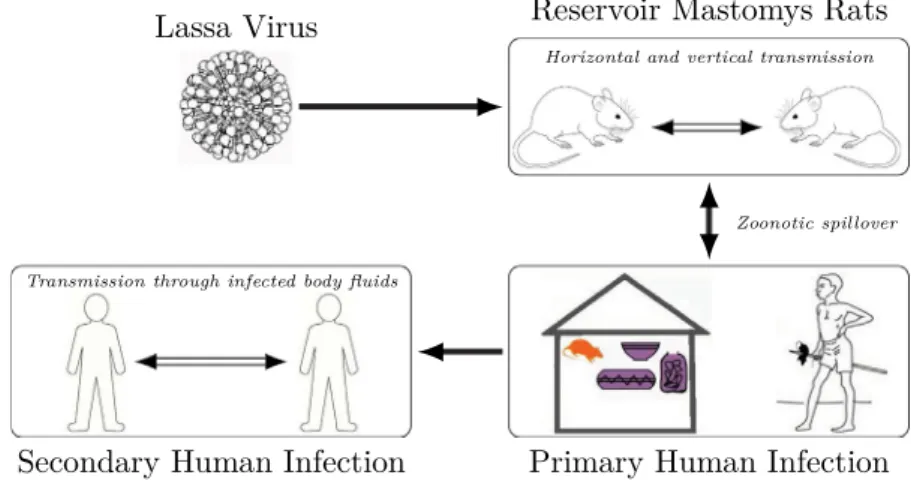
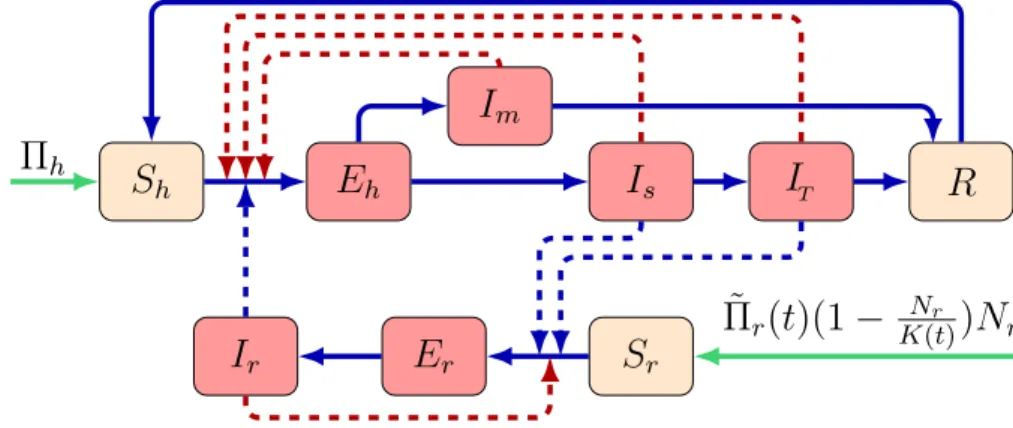
![Fig. 3. Confirmed number of cases reported of the November 2017–May 2020 Lassa fever epidemic in Nigeria [31].](https://thumb-eu.123doks.com/thumbv2/9dokorg/961285.56708/14.816.181.631.100.304/confirmed-number-cases-reported-november-lassa-epidemic-nigeria.webp)
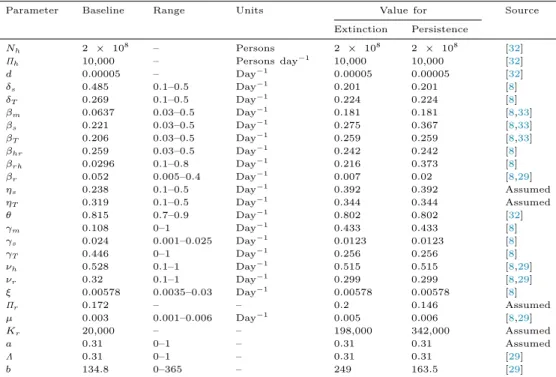
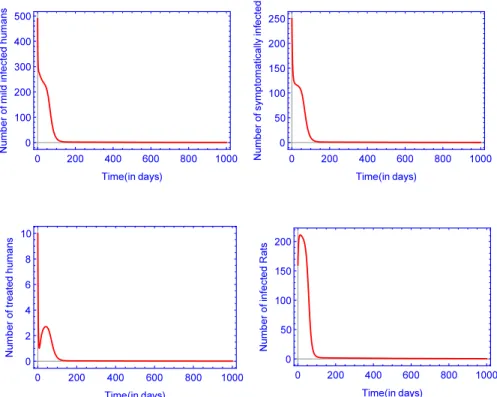
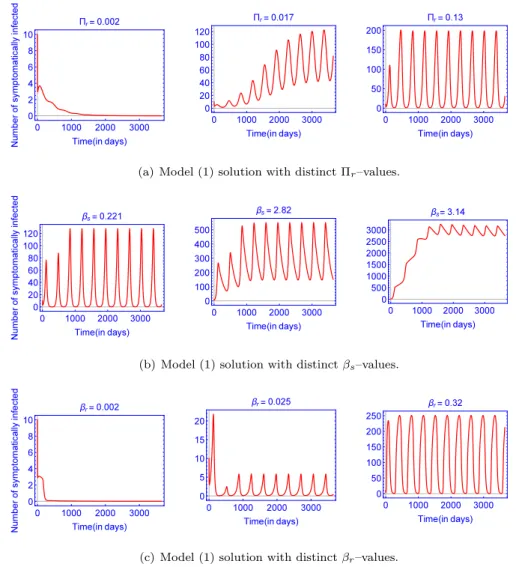
![Fig. 9. The contour plot of the time-average basic reproduction number, [R 0 ] in (a) and the basic reproduction number, R A 0 of the autonomous model in (b), as a function of maximal carrying capacity of the rats (K r ) and in a) human-to-human transmissi](https://thumb-eu.123doks.com/thumbv2/9dokorg/961285.56708/18.816.151.667.103.476/contour-reproduction-reproduction-autonomous-function-carrying-capacity-transmissi.webp)
![Fig. 10. The curves of the time-average basic reproduction number [R 0 ] and the basic reproduction number of the autonomous model R A 0 versus in a) maximal carrying capacity of rodents (K r ), b) rodents birth rate ( Π r ), c) human-to-human transmission](https://thumb-eu.123doks.com/thumbv2/9dokorg/961285.56708/19.816.157.657.100.680/average-reproduction-reproduction-autonomous-maximal-carrying-capacity-transmission.webp)